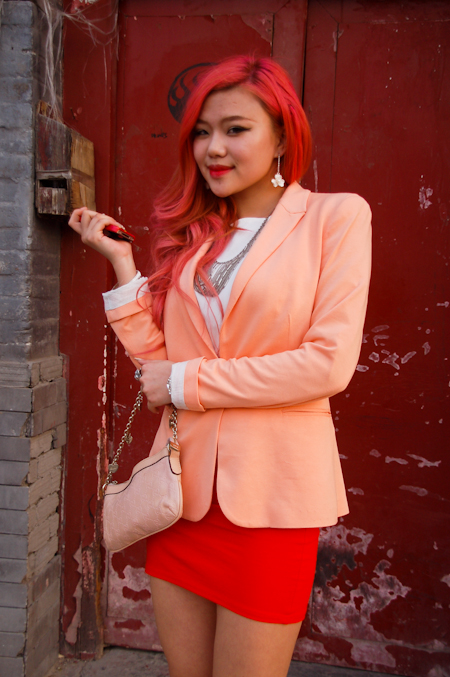“Once in his life, every man is entitled to fall madly in love with a gorgeous redhead,”
said Lucille Ball.
This music student is not obsessed with fashion trends or such a prosaic notion as good taste.
This is the sort of image that started me on Stylites – in contrast to all the images from fashion parties that I think many of you must find as tiring as I do. I have always sought an element of the unexpected, crazy, or outlandish. People constantly ask me if Beijing style is authentic or original. Do Beijing people have their own voice? They ask me if it is improving or if I think people here are well-dressed. If they don’t have their own style, is Stylites not a waste of time?
My temptation would be to say that Chinese street style is different, or more important, because China is the new center of the world. Since China dominates the newswaves and is so central to the global economy and, soon, the cultural development of the world, what its citizens are wearing must by definition be worth monitoring.
Such a response is a bit too easy though. Even if it weren’t rising so quickly in economic and political influence, and even if it weren’t the world’s most populous country, China would still have a very interesting story from a cultural and even a sartorial perspective. The last century and beyond have seen constant tumultuous changes in this massive country and sea changes in the culture and fashion sense of the citizenry. The ways in which traditional Chinese culture interacts first with Communist and then with contemporary global fashion influences is also fascinating. China has always had a unique way of engaging with and absorbing foreign culture.
Fashion is one area where there is a huge amount of influence from the West and the local fashion voice can seem rather muted. The extant to which a distinct and fresh local voice can emerge is something that we are watching.
Returning to the perhaps cliched position that China is more interesting than other places just because it is China, let me add that the act of expressing oneself in China is itself something brand new. In the context of both traditional Chinese culture and the recent Communist past, behaving individualistically, as expressed through dress, is much more of a departure – of a daring act – than any of the excesses of the 1960s. Thus Stylites tracks the emergence of the individual, and often the bohemian, as it is seen through fashion.
So yes, Stylites is not about fashion or even style, though I think many of my viewers are here for that reason. Trends, individual fashion items, and the color of the moment have never been my focus. Perhaps my more emotive approach makes it difficult for me to respond to trend-analysts, consultants, and various corporate types when they ask me what is going on in Beijing, always coming from a very business of fashion sort of perspective.

Comments are closed.